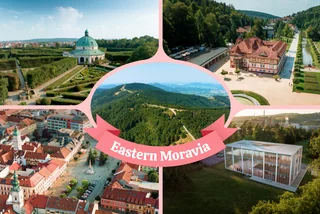Most of us have walked, or taken out-of-town visitors on a walk, through Old Town Square and up to Prague Castle. It´s an easy way to hit most of the major sites, as well as lots of beautiful buildings and quaint cobblestone streets, sure to provoke the “ahhs” of your companions. There are lots of interesting elements along the way besides the clock, the bridge and Starbucks. Here we introduce you to The Royal Route.
We begin the Royal Route at Náměstí Republiky and Obecní dům. The royal palace used to be situated here, and this path to the Castle is what the Royal Court used to walk for coronations and other such occasions. Even though Obecní dům´s café is really touristy; the building itself is one of the best examples of Art Nouveau in Prague and as a concert venue, it´s tops. Adjacent to Obecní dům is Prašná brána, or the powder tower. Founded in 1475, it´s located where the royal palace used to be.
PARTNER ARTICLE
From Náměstí Republiky head down Celetna towards Staroměstské náměstí. House signs are a unique “seek and find” aspect to Prague walking. They used to identify buildings before a numbering system came into play and some buildings still have their original signs and names. On Celetna, look for the House of the Red Eagle at #593, the House of the White Peacock at #557 and House of the Black Sun at #556. Note, these are the original “red” numbers.
Many people are already familiar with the House of the Black Madonna. It´s a Cubist building designed by Josef Gočár, and one of the best remaining examples of Cubist architecture in Prague. The Madonna is actually Baroque. The Grand Café Orient located here is an excellent café; especially if you are lucky enough to choose an order that will be served on their Cubist dishes. The Cubist Museum and gift shop here are also well-worth a visit.
Now we have reached Staroměstské náměstí, Old Town Square. The square is surrounded by many historic buildings. One Gothic example is the House of the Stone Bell at #13 which is part of the City Gallery of Prague and shows exhibitions of modern and contemporary art. At #11 & #12 is Kinsky Palace which houses part of the National Gallery´s collection. Behind both these buildings is the Gothic Týn Church. Built in the 2nd half of the 15th century; astronomer Tycho Brahe is buried there.
In the middle of the square are two points of interest. First, the can´t miss Memorial to Jan Hus. Unveiled in the middle of World War I, on the occasion of the 500th anniversary of him being burned to death as a heretic for preaching against the Catholic Church. Outrage at his death led to the Hussite Wars; and we have him to thank for a July public holiday. It´s a slightly violent ode; which recently went through a fix-up.
While carefully examining Mr. Hus from all angles, look down and you may come across the Prague Meridian. This indicates the place where the Marian Column used to cast its shadow at noon. The column, built in 1650, was torn down in 1918.
Old Town Hall and the Astronomical Clock are the most identifiable landmarks on the square, and probably in the city. The clock was built by a watchmaker, Mikuláš of Kadan at the beginning of the 15th century. A fire in May 1945 destroyed all the clock´s wooden statues. The calendar board is a copy, designed by Josef Manes in 1865; the original is in the Museum of the City of Prague. Every hour the apostles do a little procession, which lasts about ten seconds and attracts ten hundred people. Surrounding the clock are statues of a philosopher, astronomer, chronicler and a Turk. A miser gloats over his bag of gold while a vain man gazes in a mirror. At the bottom, Archangel Michael symbolizes the final judgment. Also here is the leaning tower of Prague. That´s right, that Italian city can´t claim all the slanted building fame – the old town tower leans towards the south by 23 centimeters and westward by 15 centimeters.
Right after leaving the clock and heading towards Karlova Street and Charles Bridge, you´ll pass by the Renaissance House of the Minute at #3. The murals are from the beginning of the 17th century and Franz Kafka lived here for a while.
Karlova Street is the narrow curvy street packed with people and tourist shops. There are some interesting buildings to note though. The House of the Golden Snake at #181 is where the first Prague café was opened in 1714. Don´t miss the Don Giovanni Marionette Opera and when you finally get to the bridge, the Museum of Medieval Torture Instruments.
And here it is – Charles Bridge. Built in 1357; the builder Petr Parler, was only 27. Looking around and out you can spot many other Prague landmarks such as Petřín, St. Nicholas Church, Prague Castle, Letna Park with the metronome and the National Theatre. If you turn around and look back towards Old Town, you´ll see why one of Prague´s nicknames is City of 100 Spires. Bernard Bolzano, a mathematician and philosopher counted Prague´s spires at the beginning of the 19th century and came up with 103. Today, though, Prague has more than 500.
The Bridge is guarded by two towers. The Old Town Bridge Tower was built by the same designer of St. Vitus Cathedral. The Lesser Quarter Bridge Towers are actually two; the shorter one on the left is a leftover Romanesque tower from the mid 12-century; the central gate was built in 1400 and the tower to the right was built in 1464.
Now you´ve reached Malá Strana, the quieter more upscale side of the river. First big “site” is Malostranské náměstí. Not the most impressive square in the city, mainly because of the constant construction, however just behind it is the stunning St. Nicholas Church. This Baroque church was completed in the mid-18th century and contains a huge dome and beautiful frescos. The frescos measure 3,000 square meters, making them one of the largest in Europe. Wolfgang Amadeus Mozart played the organ here, and 4,000 people crammed inside for a memorial service following his death.
Take Nerudova Street up, up, to the castle. There are lots of house signs here and examples of classic Baroque architecture. Many of the houses have been converted to hotels, and named based on their “sign;” for example, the Golden Wheel, the Green Lobster and the Red Lion.
Whew, you´ve made it to Prague Castle. Another one of Prague´s nicknames is the Golden City. The moniker comes from a couple different sources. Under Charles IV, the rooftops of Prague Castle were supposedly gilded and the impression was beautiful. Under Rudolf II, the city was known for its alchemists.
One of the most dominating sites of the Castle grounds is St. Vitus Cathedral. It´s considered a royal cathedral because coronations took place here, nobles are buried here and their crown jewels are kept here. The Bohemian crown jewels aren´t on permanent display like in other European cities, they only come out for special occasions – most recently April 2008 due to President Klaus being re-elected. They are kept behind St. Wenceslas Chapel, where the good king is buried. The door to the Crown Room where the crown jewels are kept has 7 keys, and each one is held by someone different. The church is free to enter, and you can also climb the tower and crawl in the crypts.
Off to the side of the castle is the Deer Pit and Royal Garden, whose dimensions are a near precise copy of the Castle´s size -both being 630 meters long. Most of the work was done by Italians, including Belvedere, the Summer House for Queen Anne built by Ferdinand I. Royal astronomers and astrologers, including Tycho Brahe, Jan Kepler and even Rudolf II himself used to watch the sky from the Belvedere´s balcony.
If you choose to walk down through the Castle grounds, instead of exiting by the Royal Garden, you´ll hit the newly opened St. Wenceslas Vineyards. They were actually planted by St. Charles, and reopened in June 2008 with 3 restaurants. It took 18 years to complete work on the vineyards and villa. Officials say they expect the vines to start producing wines in 5-6 years.
There you have it – a half day of royal sights, history and cultural; all discovered on your own two feet. Go reward yourself with a nice royal pivo.












 Reading time: 6 minutes
Reading time: 6 minutes 

















